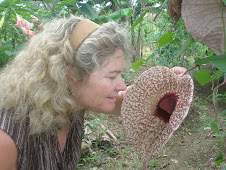I am making vast advances in my Spanish speaking abilities. A few days ago another group of college students visited the farm from Earth University. I was stoked- 18 kids my age just landed on my doorstep to learn about biodynamic farming. They came right before dinnertime, so we all gathered around the table, and their professor asked that we hold hands as quick words of welcome and intention were announced. Then he handed it over to Stephen, who also said some stuff in Spanish. Next, the spotlight turned on me, as the hostess, to say something to the group. Luckily, I had mentally rehearsed ahead of time and an elementary, sing-songy response came out:
“¡Estoy muy emocionada para mis amigos nuevos!”
My speech (I am very excited for my new friends) was met with laughter and cheers. I felt like a rockstar. The students, Stephen, and I all then proceeded to scarf down a leisurely dinner. After our hunger was attended to, one of the students, nicknamed Bob (I suspect for his killer dreads and rasta demeanor) gave a presentation on Biodynamic farming. It was conducted in Spanish, so I had a bit of a hard time catching everything, but regardless, I learned a lot. Honestly, before I got here I couldn’t tell you what exactly constituted the “bio” part, and what practices were considered “dynamic.” But thanks to Bob’s presentation on Rudolf Steiner’s work, I can classify the two as so:
Bio-Dynamic Farming Practices
Biological Practices
Green manures
Special compost preparations
Cover cropping
Special foliar sprays
Composting
Dyanic Practices
Planting by calender
Companion Planting
Peppering for pest control
Integration of crops and livestock
Homeopathy
Tillage and cultivation
Radionics
Intriguing, eh? I was lucky enough to go with the students the next morning to observe arguably the most esoteric practice of bio-dynamics: field preparation #500. We went up to the area of the farm called Juan’s Garden, which is where most of the fruits and veggies are grown that we cook at the lodge. Upon hearing what we were about to do, I was incredulous. With shovels in hand and sweat on our brows, we dug up a bunch of cow horns. The horns were buried last autumn and were placed 40-60cm below the surface. I noticed how the horns where not just just chucked into a pit; actually, the 15 or so horns neatly outlined the pit in a circle. Inside the horns was a potent humus mixture that was prepared by filling the horn with cow manure. Looking into the horn at the decomposed brown stuff, I was shocked when the students were excitedly smelling the month-old cow terds. When a German student insisted that it wasn’t bad, I took a whiff. It smelled like the rich, earthy dirt you would find in the heart of a forest. It was right then that I became a believer in Prep. #500.
Yesterday I was informed by Steven that the “damn toucans are eating all our Old Spice fruit!” Enamored by the surreal-ness of picking tropical fruit on a farm in Costa Rica, I jumped at the chance to solve this debacle. Me and a friendly farmhand named Jose headed down the road to the Old Spice tree (known as Jamaica) with a ladder and plastic baggy in hand. Sure enough, Costa Rica’s version of a wild turkey was munching away at some of the fruits on the top branches. We shooed it away and got to work. Old Spice fruit looks like small blue-berries that bunch together in the hundreds at the end of a tree limb. With Jose in the tree and me on the ladder, he would grab the elastic limbs and swing their bountiful ends towards us. Me and Jose didn’t fool around with that Old Spice- we filled our bag in less than 10 minutes. I was particularly efficient because I had forgotten bug repellent and was eager to return with less than 50 pock marks. I walked back to the Casa Luna and got to work drying the fruit. After dabbing the moisture off of them with paper towels, I delicately laid them out in an 8-layered, old school dehydrator. Tomorrow morning when I take them out, they should be just bursting with a scent that I think is similar to a cross between Christmas and masculinity. I am going to try to combine the old spice with citronella, vanilla, and some good ol' vodka to make a perfume that simultaneously acts as a natural bug repellent... I don't know about you, but I am down to attract some muchachos and repel some insectos in one spray!
Subscribe to:
Post Comments (Atom)






















1 comment:
Mara esta tu tia, Gayle, vive en Oregon!! I am enjoying your blog! You really have the gift of gab or write as the case may be. I would love to hear more about where you are, what that place is, about what they grow etc. As a gardener, I 'm fascinated. Stay safe chica. Gayle
Post a Comment